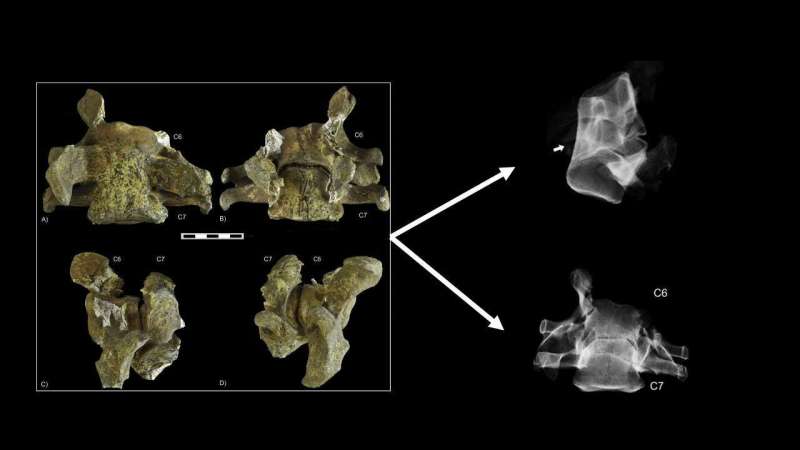First evidence for an unusual congenital pathology in cave bears

Scientists from the Centro Nacional de Investigación sobre la Evolución Humana (CENIEH) have published a paper in the International Journal of Paleopathology that describes the first case of a congenital pathology in vertebrae of a cave bear (Ursus spelaeus). The findings were based on a specimen recovered in the 2014 excavation campaign in the archaeological and paleontological site of Cueva de Guantes, in Santibáñez de la Peña (Palencia).
The provincial representative of the Junta de Castilla y León, Luis Domingo González, and the CENIEH researchers Ana Mateos and Jesús RodrÃguez, and curator of the Museo Provincial de Palencia, Javier Abarquero, reported on the archaeological and scientific results yielded by a decade of excavation campaigns, including the present study.
The bear, which lived over 30,000 years ago, suffered from congenital block vertebra (CBV), a disorder occurring during the fetal stage that hampers the proper development of the spinal column. The specific case in the paper describes a bone anomaly affecting the last two cervical vertebrae (C6-C7), which appear connected instead of separated.
This finding is the first evidence of a pathology of this kind in a prehistoric bear. Although not unheard of in other mammals, it is found very rarely (2 to 3 percent), indicating how unusual this discovery is. Despite the striking nature of the lesion, it is not very likely that the condition affected its owner's life or survival. The pathological specimen was recovered during the 2014 excavation campaign and has been deposited in the Museo de Palencia.
The Cueva de Guantes is a system of cavities situated in the municipality of Santibáñez de la Peña, between the localities of Villanueva de Arriba and Villaoliva de la Peña. Fieldwork has been under way in these caves for more than a decade, by a team of scientists from the CENIEH, the IPHES, the UCM and the MAR.
These investigations in the area of La Peña have verified the presence of Neanderthal humans in these foothills to the south of the Cordillera Cantábrica, something unknown until recently in the Paleolithic context in the northern Meseta. Further, the evidence of thousands of cave bear remains in Cueva de Guantes is of particular significance for studying the biology of an extinct bear species.
"The most recent excavation campaign in GalerÃa 1 at Cueva de Guantes has allowed us to confirm the hypothesis that there were, at least, two moments of Neanderthal human occupation in this gallery," says Mateos. "GalerÃa 1 was also used as a place of hibernation by cave bears during the Upper Pleistocene. The thousands of remains of Ursus spelaeus recovered allow us to establish that cave bears occupied this part of the cave repeatedly, and for quite a long time. To date, we have found remains of at least 18 individuals," says RodrÃguez.
The researchers say that these findings serve to corroborate the importance of the karstic system of Cueva de Guantes, with four different locations excavated over 10 years of investigation. The landscape called La Loma, with its innumerable closed cavities and galleries, has turned out to be a territory occupied and frequented by human populations for millennia.
More information: Daniel Fuentes-Sánchez et al. Evidence of congenital block vertebra in Pleistocene Cave Bear (Ursus spelaeus) from Cueva de Guantes (Palencia, Spain), International Journal of Paleopathology (2018).
Provided by CENIEH



















